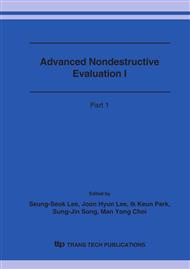p.1601
p.1605
p.1609
p.1616
p.1620
p.1624
p.1629
p.1636
p.1640
Characteristics of Crack Detection on Plates Using Strain Mode Shapes; Sensor Grids and Geometry
Abstract:
The existence of a crack in a structure produces changes in modal parameters of it such as natural frequencies, damping, displacement and strain mode shapes. This paper is focused on characterization of crack detection methods using strain mode shapes. To characterize crack detection methods, we changed sensing grids from corner grid to cross grid and geometry of the specimens from rectangular to triangular plate. Rest of conditions was fixed. For crack detection criteria, COMAC, ECOMAC, ADSM and new method have been used and the results are compared with each other. The COMAC, ECOMAC and ADSM showed limited capacity of crack detection on plates but the new method gave good results in 90% of all cases.
Info:
Periodical:
Pages:
1620-1623
Citation:
Online since:
October 2006
Authors:
Keywords:
Price:
Сopyright:
© 2006 Trans Tech Publications Ltd. All Rights Reserved
Share:
Citation:


